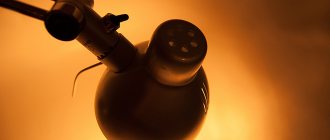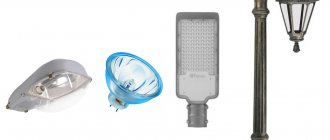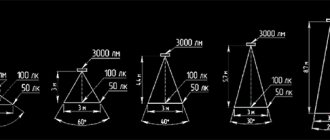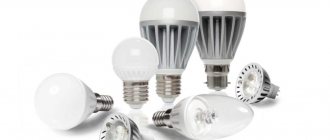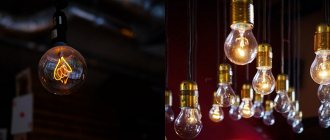The color temperature of LED lamps is one of the main values that characterizes lighting technology. It must be taken into account both when designing a room and when choosing car lamps. Color temperature is a broad concept that includes such characteristics as spectral properties, emission color, color rendering index, etc.
Warm and cool light from LED lamps
The color temperature of all incandescent lamps is approximately the same, with values ranging between 2,000 and 3,000 Kelvin. The warm yellow glow is characterized as pleasing to the eye, cozy and relaxing. LED sources vary more: color temperature ranges from 2700 to 6500 K. At the same time, the range from 2700 to 3300 Kelvin is warm white light, from 3300 to 5000 is neutral white, more than 5000 is cool white.
LED color temperature
In an LED, light is emitted by a special phosphor coating. Traditionally, all LED lighting sources are divided into three groups according to the spectrum:
- Warm white (up to 3500K);
- neutral white (3500K – 5200K);
- cool white (above 5200K).
Conventionally, we have the following table of color temperature of LED lamps:
What is the color temperature of LED lamps
From the point of view of physics, light temperature is the spectrum emitted by a heated body relative to an absolutely black body. What does lamp color temperature mean? This is the color of the glow of a body heated to the appropriate temperature.
Accordingly, the color of LED lamps has three gradations - yellow (up to 3200K), white (4000-5500K) and white-blue (above 5500K). The higher the temperature, the shorter the wavelength of the emitted light beam.
There are sources with colors above 9000K, but they cannot be used for lighting. We see objects due to the fact that light is reflected from their surface. As the color temperature increases, the wavelength decreases; the shorter it is, the “worse” the light is reflected from surrounding objects.
If you put an 18,000K LED in a powerful flashlight, an outside observer will be able to notice it several kilometers away, but under your feet it will create a spot only tens of centimeters in size.
Color rendering index and color temperature
The color rendering index characterizes the ability to perceive color gradations. When the light temperature of LED lamps is below 3200K, color perception is significantly reduced. Try pulling out a green or brown color from a box of colored pencils by candlelight. Believe me, the task will not be easy.
The color rendering index is very clearly regulated for automotive LED lamps, because if color rendering is poor, a situation may arise when the driver cannot distinguish between the road surface and the side of the road.
Color temperature and lighting quality
It would seem why we need LEDs of warm and cold colors if they are not able to provide normal perception conditions.
One of the main areas of application of LEDs with low color temperature (2400K-3000K) is lighting in a “noisy” optical environment. Simply put, lighting in poor visibility conditions.
Let's take a car head start. In heavy fog, white light, due to its short wavelength, is reflected from water spray, which significantly limits the visibility range. Yellow light has a wavelength several times longer; it does not reflect from small objects, but bends around them. That's why fog lights in cars are made yellow.
At the same time, short waves propagate further without attenuation. As an analogy, consider radio waves and hard short-wave X-rays. Even a thin sheet of metal blocks radio waves, and thick lead is used to protect against x-rays. Cool white light is used in long-distance warning systems, floodlights, signal and search lights.
Application of LED lamps with warm light
Since a warm glow promotes relaxation, lamps and luminaires that produce it are best suited for living spaces. Using LED light sources with a color temperature of up to 3300 K, lighting is created for bedrooms, children's rooms, and recreation areas. They can also be placed above the dining table - the food will look more attractive and people will feel more comfortable. By the way, owners of cafes and restaurants often resort to the trick of “appetizing” lighting.
However, there are exceptions to the general rule. If the room is decorated in cold blue-green tones, warm light will noticeably distort them, making blue wallpaper greenish and blue wallpaper faded. The solution is to install lamps with a neutral or cool glow.
Light colors
Determining a cold object without radiation does not create any difficulties. One of the main reflective parameters of such an object is the wavelength or its inverse characteristic - frequency. If we are talking about a heated radiating body, then things are different.
A completely black body does not reflect light rays. An example is the tungsten filament in a standard electric lamp. Let's figure out how such a light bulb is connected through a rheostat to an electrical circuit.
Below is the sequence of observations:
- The light is on, electricity is transmitted to the terminals.
- The resistance level is slowly decreasing.
- A completely black body begins to glow slightly red.
If you check the temperature of the object at this moment, it will be at 900 degrees above zero. According to the law of superconductivity, at zero Kelvin temperature the speed of atoms will also be zero. However, it is the speed that determines the radiation.
Using LED lamps with neutral light
LED neutral light lamps are a universal solution for both residential and public spaces. Their glow promotes vigor and improves work spirit. Such light sources are installed in bathrooms, hallways, kitchens, above desks and other surfaces. Most institutions, shops, offices and educational institutions are equipped with devices with a color temperature of 3300 - 5000 Kelvin.
Neutral light distorts colors less than others and is suitable for interiors in both warm and cold tones.
How to choose a lamp for your home
To choose a light bulb for use in one of the rooms, you need to be guided by the following criteria in addition to color temperature:
- Operating principle. These include standard incandescent, LED, halogen, and fluorescent lamps. The latter are less suitable for use at home because they flicker strongly and have a very high color temperature. LED elements do not have a significant impact on the eyes or interior items, since they are local (point) lighting elements.
- Efficiency LEDs come first here. The last one has incandescent lamps.
- Color rendering index. Marked as Ra. An indicator from 83 to 100 is considered optimal. The higher it is, the less colors will be distorted when illuminated by such a lamp.
- Type of flask. It can have the shape of a spiral, pear, candle, tube, ball, etc. You can determine the required shape by the type of floor lamp/lampshade (open, closed).
- Price. Incandescent lamps are considered the cheapest. The most expensive are energy-saving ones. But the price of such elements is fully compensated by the low power consumption.
How much to spend on an element is determined by each master for himself.
Cold light LED lamps: scope of application
The “specialization” of cold light lamps is illumination of industrial and other work areas, medical offices, illumination of display cases with jewelry. Fixtures that create a cool glow should be used with caution due to the weakening of red and yellow tones. Thus, red acquires violet “notes”, orange turns brown, and yellow becomes greenish. In addition, light sources with a temperature of more than 5000 K can create a tense and unsettling atmosphere, especially in a small space.
The full range of LED lamps is presented in the catalog.
Color perception
Each person's color perception is individual. The perception of each color is a compromise result obtained based on the processing of the signal received by the optic nerves. Perceived shades can vary significantly from person to person.
You should also take into account the fact that color perception becomes distorted with age. In particular, the lens acquires a yellowish color, which makes adjustments to the perception of information coming from the optic nerves. Also, the psychological factor plays a significant role in color perception.
It is generally accepted that the human eye can distinguish up to 10 million shades. Moreover, more than four hundred of them belong to varieties of achromatic gray color. However, such a number of perceived shades should not be misleading: for example, a ray of sunlight easily distorts color perception.
Guidelines for choosing LED light bulbs
Determining a suitable LED spotlight is not as straightforward as choosing an incandescent lamp. The power of the illuminator is far from the only parameter that needs to be taken into account when purchasing.
Luminous flux characteristics
The traditional power indicator, measured in watts, is not so relevant when choosing an LED lamp. It is incorrect to talk about the brightness of an LED illuminator based on its energy consumption. Light bulbs made using different technologies consume different amounts of electricity with the same brightness.
It is more correct to evaluate the equivalent power, as well as the luminous flux.
For the convenience of consumers, many manufacturing companies indicate on the packaging what incandescent lamp power corresponds to the glow of the LED product. For example, a 12 W LED light produces approximately the same amount of light as a regular 100 W lamp
If this information is not displayed, then you can focus on the average indicator - lighting from LEDs is 5 times higher than an incandescent lamp with equal power consumption.
A more accurate idea of the quality of light is given by the luminous flux value. The parameter characterizes the brightness of the lamp and is displayed in lumens. The choice of illumination depends on the purpose of the room.
Recommended standards according to SNiP 23-05-95 per 1 sq.m:
- kitchen, bedroom, living room – 150 lm;
- children's room, office - 200 lm;
- bathroom, corridor – 50 lm.
Knowing the area of the room, it is easy to calculate the required amount of luminous flux. The brightness value of the diode lamp, as well as the power, is indicated on the packaging. However, it is better to take a device with a small margin of illumination, since manufacturers often overestimate this characteristic.
The graph clearly shows the correspondence between the luminous flux of different types of light bulbs and the power consumed. The brightness index is a universal parameter that allows you to compare and evaluate the quality of illumination of spotlights
Color spectrum - glow temperature
The emission spectrum of the LED lamp varies from warm yellowish to cool blue. The hue is determined by the color temperature, which is in the range of 1800-6600°K.
The choice of glow tone depends on personal preferences, the purpose of the lighting and the surrounding interior. It is worth considering that all colors of light are perceived differently by humans:
- 2700 K – warm white – promotes relaxation, rest, applicable in a cozy environment, for example, a bedroom;
- 3000 K – yellow-white – slightly cooler than the previous one, recommended for the living room and children’s room;
- 3500 K – daytime white – increases performance; such lamps are suitable for cabinets and local illumination of mirrors;
- 4000-4800 K - neutral white - perfectly complements interiors in the high-tech style, minimalism, but somewhat suppresses the feeling of comfort; spotlights are installed in public spaces and offices.
Lighters with a glow temperature of more than 5000 K are not recommended for home use. Their purpose is to illuminate streets, industrial and warehouse facilities.
The temperature indicator is indicated among other characteristics on the packaging or housing of the LED light bulb. Some manufacturers give a short description of the shade of the glow, for example, “warm yellow light”
Color rendering index value
Lamps of the same glow temperature can convey the colors of surrounding objects differently. Unlike incandescent light bulbs, diode light bulbs have a limited spectrum, which can lead to distortion of the real picture.
The correctness of shade perception depends on the color rendering coefficient. The index is designated as CRI or Ra.
CRI is a relative value within 100 that indicates how well different colors are visible when illuminated by a lamp. The standard is sunlight, its CRI=100. Incandescent light bulbs also have a high color rendering index – 97-98.
White LEDs typically have a color rendering index of 70-90. For residential lighting, it is better to choose products with CRI>80
Light ripple factor
When thinking about how to choose a high-quality LED lamp for your home, many people forget about such an important parameter as flicker. But it is the pulsation of light that often causes eye fatigue and a deterioration in general well-being.
Manufacturers often do not indicate the degree of flicker of a light bulb. Significant pulsation is perceived as a stroboscopic effect - when you sharply turn your head or shift your gaze.
The presence of flicker can be determined experimentally. Point a pencil at the glowing lamp and quickly twirl it in a semicircle. The absence of extraneous contours indicates safe lighting; if there are “several pencils,” it means the light is pulsating.
An alternative method is viewing through a smartphone camera. If there are stripes on the screen (Fig. 1), then the light from the LED lamp is pulsating. Image without distortion (Fig. 2) - no flicker, dangerous to the eyes
SNiP standards establish that the permissible light pulsation coefficient for a workplace is 10-20%, for a living space - 30%. Requirements are made for pulsations with a frequency within 300 Hz. The retina does not respond to flickering above 300 Hz.
High-quality diode light sources have a flicker degree of up to 5%, incandescent lamps - 8-32%.
Base type and operating voltage
LED bulbs are produced for different types of lamps, which allows you to choose a diode for any need. In everyday life, the most popular illuminators are those with the following bases:
- E14, E27 – used mainly for floor lamps, chandeliers, wall sconces;
- GU 10, G4 – designed to replace a halogen bulb of the appropriate size and spot lighting.
Most LED lights are powered by a voltage of 220 W. If you have a high-quality driver, the lamp may not be afraid of surges on the electrification line. Some manufacturers preset a wide voltage range - 110-220 W.
A number of modifications are designed for 12 W. To connect them, a pulse converter is required that provides a stabilized voltage.
You can determine the type of power supply by the base. Lamps E27, E14, GU10, G9 operate on alternating current, soffits G4, MR16, MR11, G53 are low-voltage and require DC power
In the marking of a light bulb, the letter symbol indicates the type of base, and the number indicates its diameter or the distance between the contacts.
Dependence of the scattering angle on the shape of the bulb
Due to their design features, LEDs emit light in a small angular range. In the absence of optical elements, the diode illuminates the front hemisphere. To expand the range of action, secondary optics are used: diverging, focusing lenses and polycarbonate matte bulbs.
The angular range of illumination depends on the shape of the lamp itself. Convex bulbs scatter light over a larger space.
An example of the light pattern of light bulbs with different frosted bulbs: 1 – A60, glow angle – 120-180°, 2 – A67, illumination coverage – up to 300°
The first type of lamps is mainly used in lamps where the shade is directed downwards - table lighting. The second type is similar to the effect of incandescent lamps and is used to organize the main light.
Lighting angle diagrams: 1 – “candle” with E14 base, 2 – Filament lamps with a transparent bulb, 3 – spherical bulb, 4 – “corn”
Of the above modifications, each has a specific spectrum of action and purpose:
- “candle” - the luminous flux is emitted in different directions, the front hemisphere is poorly illuminated; light bulbs are suitable for chandeliers where the bulb is aimed at the ceiling;
- Filament - suitable for general lighting, but not used to illuminate the workplace;
- spherical bulb - operating range - 200-270°, similar to incandescent lamps;
- “corn” - a glow angle of 270° allows you to use the light bulb as the main lighting.
LED luminaires with GU10 and MR16 sockets operate in the range of 15-135°. Conventionally, they can be classified into accent and general lighting.
Light range diagrams: 1 – accent lamp, 2 – bulb with a diffuse lens, 3 – “candle with petals”, 4 – cone lens
Bulbs with a cone lens have unusual light dispersion. Unlike models with frosted bulbs, uneven dispersion is observed here. These LEDs are suitable for lamps with shades and shades.
Attention to the quality of the radiator
The heat sink function in LED lamps is performed by radiators. Coolers differ in material, manufacturing and design.
The following options are possible:
- aluminum (ribbed and smooth);
- ceramic;
- composite;
- plastic.
Aluminum radiator. The metal cooler has high thermal conductivity and is lightweight.
Aluminum radiators come in two types: ribbed and smooth. The former are considered more efficient, the latter are used in small and inexpensive light bulbs
Plastic. An inexpensive option for diode illuminators with average efficiency. The radiator is made of thermo-dissipating polymer. To increase the thermal conductivity, additional ventilation holes are made in the housing.
Composite The radiator is made of aluminum and enclosed in a thin plastic shell. Lamps with composite radiators are in demand due to the optimal price/quality tandem.
Ceramic cooler. It looks like plastic, but the material is heavier and smoother to the touch. F17
The ceramic radiator does not conduct current - this allows LED modules to be placed on the cooler, which leads to more intense heat dissipation
You should not rely on a ceramic radiator in cheap products. However, there is no point in avoiding plastic coolers - they last a long time and will definitely “work out” the money spent.
Lamps with a corrugated aluminum or ceramic radiator can be installed where heat dissipation is critical. A striking example is lamps built into furniture or the under-ceiling space of a stretch fabric.
Additional features of diode spotlights
LED light bulbs are rightfully considered a smart device; some of them, in addition to performing the main task, have additional functionality. The most popular option is the ability to adjust the brightness of the light.
This function is not provided in all LED lamps, but only in models with a built-in dimmer.
Diode light bulbs do not change the shade of lighting when the brightness decreases; the minimum degree of dimming is about 5-20%. Products that support luminous flux adjustment are marked - Dimmable
Some modifications are equipped with RGB LEDs that emit a full range of rainbow colors. For off-line operation, LED lamps are complemented by a built-in power supply battery.
High-tech devices are equipped with pulse drivers with microcircuits that allow you to control the lighting in the room remotely or via Wi-Fi
Working life and warranty period
The average operating period of diode products is 10-40 thousand hours. This means working normally for about 3-4 years in a residential environment. In practice, the service life of light bulbs may exceed this value.
Recent developments by European and Japanese manufacturers allow us to talk about increasing the performance of lamps up to 100 thousand hours. And even after this period, the illuminator continues to function, but with a decrease in brightness by 30-40%.
However, there are products that fail within the first three to four months of operation. Quick breakdown is typical for cheap Chinese products.
The quality of an LED lamp is largely determined by the manufacturing company - in this regard, savings are not justified. Reliable manufacturers provide a product warranty of up to five years
After purchasing a light bulb, you need to take a photo of the receipt. If the lamp fails ahead of schedule, you can exchange it under warranty by presenting a photo if the receipt fades or is lost.
Features of LED light
A light-emitting diode is a semiconductor device that produces a glow when electric current passes through it. The light that such a diode is capable of emitting is located in a fairly narrow spectral range. In this case, the color itself will depend on the material from which the LED semiconductor is made. The formation of white color in such products is achieved in the following ways:
- combining diodes of different glow colors to produce white light. This method allows you to obtain excellent color quality with the ability to adjust it. But this method is quite expensive, which affects the price of products that are not available to everyone;
- the use of phosphors to coat diodes. This is a fairly cheap and beneficial method that allows you to achieve a higher color rendering coefficient. But here, due to the applied phosphor coating, the luminous efficiency decreases.
Lamp structure
An LED light bulb consists of several diodes or, as they are sometimes called, chips. In addition, there is a driver, which is a device that converts alternating current with a voltage of 220 volts into the direct current necessary to power the diodes. Thanks to this structure, these light sources create a directional luminous flux, which is characterized by the directional angle for the generated glow.
What you need to know
When choosing LED light bulbs, you need to know that they have such a parameter as operating color temperature. It reflects the level at which the light source will produce enough glow. Here it is necessary to remember that car headlights or home lamps must have different glow temperature parameters. Otherwise, they will not be able to effectively illuminate the space around them. When the temperature is within 5000K, the spectral composition of the emitted light will be more balanced. Here it will be almost identical to daytime sunlight. The color rendering index with these parameters will be equal to 100. However, the maximum color temperature is rarely used, since borderline conditions can harm the eyes.
Colorful temperature
Note! As the color temperature decreases, the glow will become more red and less blue. And the higher the indicator, the more blue and green colors will be in the glow. This is clearly seen in the example of an incandescent lamp, which creates a glow with a reddish tint.
LED lamps in this aspect have the following positive aspects:
- The lamp housings do not get hot. In fact, heating still occurs here, but it is almost imperceptible. Heating when using this kind of lamps is noticeable only in the example of LED strip. But here, too, the main heating comes only from the power supply. The product bodies themselves do not heat up;
- create high-quality white light, which is most suitable for our eyes when it comes to artificial lighting.
Car lighting
Such parameters have made it possible to widely use LEDs for illuminating houses, streets and cars. It’s worth dwelling on the latter case in more detail, since the car can have LED tuning of both the headlights and the entire body. However, there are also disadvantages here. So, despite the fact that such products hardly heat up, and their bodies do not deform due to constant overheating, they do not always effectively reproduce other shades of light.




